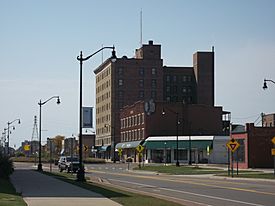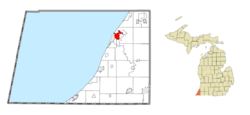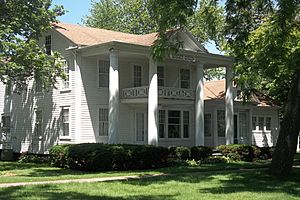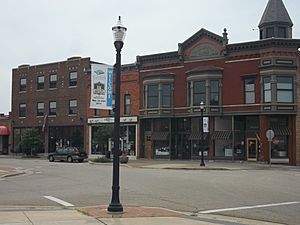Benton Harbor, Michigan facts for kids
Quick facts for kids
Benton Harbor, Michigan
|
||
|---|---|---|

Main Street in Downtown Benton Harbor
|
||
|
||

Location within Berrien County
|
||
| Country | United States | |
| State | Michigan | |
| County | Berrien | |
| Incorporated | 1837 (village) 1891 (city) |
|
| Government | ||
| • Type | Council–manager | |
| Area | ||
| • Total | 4.63 sq mi (12.00 km2) | |
| • Land | 4.38 sq mi (11.35 km2) | |
| • Water | 0.25 sq mi (0.65 km2) | |
| Elevation | 591 ft (180 m) | |
| Population | ||
| • Total | 9,103 | |
| • Density | 2,077.84/sq mi (802.27/km2) | |
| Time zone | UTC-5 (Eastern (EST)) | |
| • Summer (DST) | UTC-4 (EDT) | |
| ZIP code(s) |
49022, 49023
|
|
| Area code(s) | 269 | |
| FIPS code | 26-07520 | |
| GNIS feature ID | 0621144 | |
Benton Harbor is a city in Berrien County, Michigan. It's about 46 miles southwest of Kalamazoo. In 2020, about 9,103 people lived there.
Benton Harbor and the city of St. Joseph are very close. They are separated by the St. Joseph River. Because of this, they are often called the "Twin Cities."
Contents
History of Benton Harbor
Benton Harbor was started by Henry C. Morton, Sterne Brunson, and Charles Hull. They even have schools named after them! The area was originally a wetland. A canal was built through the Paw Paw River, which is why "harbor" is in the city's name.
In 1860, the village was planned and first called Brunson Harbor. The canal was finished in 1862. It was important for draining the marshy land and for ships to dock. The canal helped the town become a center for shipping and making things.
In 1866, the name changed to Benton Harbor. This was to honor Thomas Hart Benton, a senator who helped Michigan become a state. Benton Harbor became a village in 1836 and a city in 1891.
Starting in the 1950s, many stores moved out of the city. This led to a difficult economic time for Benton Harbor between 1970 and 1985.
The House of David was a religious group that started here. They used to run a fun amusement park in the area.
Community Challenges
Benton Harbor has experienced some community challenges over the years.
Events in 1966
In August 1966, some community tensions arose. These were related to recreational facilities and how police interacted with Black residents. To help restore peace, the Michigan National Guard was called in. They stayed until the situation calmed down on September 5.
Events in 2003
In June 2003, there were community protests for two days. This happened after a motorcyclist died following a police chase. Many state troopers and police from nearby towns came to Benton Harbor.
Later, these events helped bring the Jimmy Carter Work Project to Benton Harbor and Detroit in 2005. This project helps build homes for people in need.
Water Quality Concerns
In 2018, tests showed higher-than-safe levels of lead in Benton Harbor's tap water. The water sometimes looked "bubbly and white" or "brown" and had a bad taste and smell. This was because of old lead pipes that carried water.
Lead in water can be harmful to health. So, people in Benton Harbor were given free bottled water for drinking, brushing teeth, and cooking. In September 2021, $10 million was set aside to replace all the lead pipes. By December 1, 2023, all lead pipes in the city had been replaced.
Geography and Climate
Benton Harbor covers about 4.68 square miles (12.12 square kilometers). Most of this is land, with a small part being water.
Local Climate
Benton Harbor has a climate with warm summers and less cold winters compared to some other places. In winter, there is a lot of snow because of the "lake effect" from Lake Michigan. Summer temperatures usually range from 77 to 83 degrees Fahrenheit (25 to 28 degrees Celsius) between June and August. The nights are usually mild, which helps keep the heat from feeling too strong.
| Climate data for Benton Harbor, Michigan (Benton Harbor Airport) 1991–2020 normals, extremes 1887–present | |||||||||||||
|---|---|---|---|---|---|---|---|---|---|---|---|---|---|
| Month | Jan | Feb | Mar | Apr | May | Jun | Jul | Aug | Sep | Oct | Nov | Dec | Year |
| Record high °F (°C) | 68 (20) |
71 (22) |
86 (30) |
90 (32) |
97 (36) |
104 (40) |
104 (40) |
102 (39) |
98 (37) |
94 (34) |
82 (28) |
69 (21) |
104 (40) |
| Mean daily maximum °F (°C) | 33.2 (0.7) |
35.7 (2.1) |
46.8 (8.2) |
59.3 (15.2) |
70.1 (21.2) |
79.5 (26.4) |
83.1 (28.4) |
81.4 (27.4) |
75.5 (24.2) |
63.1 (17.3) |
49.4 (9.7) |
37.8 (3.2) |
59.6 (15.3) |
| Daily mean °F (°C) | 26.3 (−3.2) |
28.5 (−1.9) |
37.3 (2.9) |
48.1 (8.9) |
58.5 (14.7) |
68.1 (20.1) |
72.6 (22.6) |
70.9 (21.6) |
64.5 (18.1) |
53.4 (11.9) |
41.6 (5.3) |
31.6 (−0.2) |
50.1 (10.1) |
| Mean daily minimum °F (°C) | 19.5 (−6.9) |
21.2 (−6.0) |
27.7 (−2.4) |
36.9 (2.7) |
47.0 (8.3) |
56.6 (13.7) |
62.1 (16.7) |
60.4 (15.8) |
53.6 (12.0) |
43.8 (6.6) |
33.8 (1.0) |
25.3 (−3.7) |
40.7 (4.8) |
| Record low °F (°C) | −21 (−29) |
−13 (−25) |
−9 (−23) |
9 (−13) |
23 (−5) |
31 (−1) |
37 (3) |
36 (2) |
23 (−5) |
15 (−9) |
−1 (−18) |
−15 (−26) |
−21 (−29) |
| Average precipitation inches (mm) | 2.46 (62) |
1.89 (48) |
2.26 (57) |
3.76 (96) |
3.85 (98) |
3.60 (91) |
3.30 (84) |
3.90 (99) |
3.40 (86) |
4.40 (112) |
3.01 (76) |
2.33 (59) |
38.16 (969) |
| Average snowfall inches (cm) | 29.5 (75) |
18.8 (48) |
7.7 (20) |
1.1 (2.8) |
0.0 (0.0) |
0.0 (0.0) |
0.0 (0.0) |
0.0 (0.0) |
0.0 (0.0) |
0.2 (0.51) |
3.8 (9.7) |
16.6 (42) |
77.7 (197) |
| Average precipitation days (≥ 0.01 in) | 13.6 | 9.6 | 9.7 | 12.3 | 11.4 | 9.7 | 7.6 | 9.0 | 9.1 | 11.1 | 10.2 | 12.6 | 125.9 |
| Average snowy days (≥ 0.1 in) | 10.2 | 7.6 | 3.0 | 0.8 | 0.0 | 0.0 | 0.0 | 0.0 | 0.0 | 0.1 | 2.1 | 7.3 | 31.1 |
| Source: NOAA | |||||||||||||
Population and People
| Historical population | |||
|---|---|---|---|
| Census | Pop. | %± | |
| 1870 | 661 | — | |
| 1880 | 1,230 | 86.1% | |
| 1890 | 3,692 | 200.2% | |
| 1900 | 6,562 | 77.7% | |
| 1910 | 9,185 | 40.0% | |
| 1920 | 12,233 | 33.2% | |
| 1930 | 15,434 | 26.2% | |
| 1940 | 16,668 | 8.0% | |
| 1950 | 18,769 | 12.6% | |
| 1960 | 19,136 | 2.0% | |
| 1970 | 16,481 | −13.9% | |
| 1980 | 14,707 | −10.8% | |
| 1990 | 12,818 | −12.8% | |
| 2000 | 11,182 | −12.8% | |
| 2010 | 10,038 | −10.2% | |
| 2020 | 9,103 | −9.3% | |
| U.S. Decennial Census 2010 2020 |
|||
2020 Census Information
| Race / Ethnicity (NH = Non-Hispanic) | Pop 2000 | Pop 2010 | Pop 2020 | % 2000 | % 2010 | % 2020 |
|---|---|---|---|---|---|---|
| White alone (NH) | 600 | 641 | 679 | 5.37% | 6.39% | 7.46% |
| Black or African American alone (NH) | 10,303 | 8,899 | 7,569 | 92.14% | 88.65% | 83.15% |
| Native American or Alaska Native alone (NH) | 17 | 30 | 24 | 0.15% | 0.30% | 0.26% |
| Asian alone (NH) | 15 | 6 | 13 | 0.13% | 0.06% | 0.14% |
| Pacific Islander alone (NH) | 4 | 4 | 5 | 0.04% | 0.04% | 0.05% |
| Other Race alone (NH) | 8 | 12 | 44 | 0.07% | 0.12% | 0.48% |
| Mixed race or Multiracial (NH) | 170 | 226 | 302 | 1.52% | 2.25% | 3.32% |
| Hispanic or Latino (any race) | 65 | 220 | 467 | 0.58% | 2.19% | 5.13% |
| Total | 11,182 | 10,038 | 9,103 | 100.00% | 100.00% | 100.00% |
2010 Census Overview
In 2010, Benton Harbor had 10,038 people living in 3,548 households. About 44% of households had children under 18. The average household had 2.77 people.
The city's population was mostly African American (89.2%) and White (7.0%). About 2.2% of the population was Hispanic or Latino. The average age in the city was 28.3 years old. About 35% of residents were under 18.
Education in Benton Harbor
Benton Harbor has two main educational places:
- Benton Harbor Area Schools: These are the local public schools.
- Lake Michigan College: This is a two-year community college located just east of the city.
Economy and Jobs
Whirlpool Corporation is a very important company in the area. It's the world's largest maker of major home appliances. Its main office is in nearby Benton Charter Township. Whirlpool also has a campus in Benton Harbor and a technical center in St. Joseph.
Community Groups
The Black Autonomy Network Community Organization (BANCO) is a group that works for political and social justice in Benton Harbor.
Getting Around: Transportation
Benton Harbor has several ways to get around:
Major Roads
 I-94: This highway goes around the city. It connects to Kalamazoo and Detroit to the east, and to Michigan City, Indiana and Chicago, Illinois to the southwest.
I-94: This highway goes around the city. It connects to Kalamazoo and Detroit to the east, and to Michigan City, Indiana and Chicago, Illinois to the southwest. BL I-94: This road goes through the downtown areas of both Benton Harbor and St. Joseph.
BL I-94: This road goes through the downtown areas of both Benton Harbor and St. Joseph. I-196: This highway starts nearby and goes north towards Holland and Grand Rapids.
I-196: This highway starts nearby and goes north towards Holland and Grand Rapids. US 31: This is a freeway that connects downtown Benton Harbor.
US 31: This is a freeway that connects downtown Benton Harbor. M-63: This road connects to I-196 and goes through downtown St. Joseph.
M-63: This road connects to I-196 and goes through downtown St. Joseph. M-139: This road starts near Niles and ends near Benton Harbor.
M-139: This road starts near Niles and ends near Benton Harbor.
A bridge called the Charles Freeman Joseph bridge opened in 2005. It connects Benton Harbor to St. Joseph across the Paw Paw River. It's named after Benton Harbor's first Black mayor.
Trains
The Amtrak station in St. Joseph has a daily passenger train called the Pere Marquette.
Buses
The Twin Cities Area Transportation Authority (TCATA) provides bus service. They have three main routes: Red, Green, and Blue. These buses help people travel throughout Benton Harbor and nearby areas.
Air Travel
The Southwest Michigan Regional Airport offers flights for non-commercial planes.
Shipping by Water
Both Benton Harbor and St. Joseph are commercial ports. This means large ships called lake freighters can bring goods to the cities by water.
Media and News
Benton Harbor has its own newspaper, The Herald-Palladium, which has offices in nearby St. Joseph Township. There's also the Benton Spirit, a community newspaper that has served the area for over 10 years.
You can also listen to several local radio stations like WCXT, WCSY-FM, and WHFB.
Fun Places to Visit
Here are some interesting places in Benton Harbor:
- Shiloh House: Built in 1910, this building was once part of the House of David religious group.
- Morton House: This historic house was built in 1849 and is now a museum.
- Jean Klock Park: A beautiful park located on Lake Michigan.
- the Golf Club at Harbor Shores: A great place for golf.
There is also a large fruit market in nearby Benton Township. The main shopping center in the area is The Orchards Mall.
Sports and Activities
Benton Harbor has been home to some basketball teams, like the Twin City Ballers and the Lake Michigan Admirals.
A famous boxing match happened here on September 6, 1920. Jack Dempsey defended his heavyweight title against Billy Miske.
The city also hosts the Maytag Ironman 70.3 Steelhead triathlon. This is a big event where athletes swim, bike, and run long distances. It's a qualifying event for a world championship!
Benton Harbor is the birthplace of Iris Kyle. She is a very successful professional bodybuilder, winning many major titles.
Festivals and Events
Benton Harbor and St. Joseph together host the annual Blossomtime Festival. This is a popular event that celebrates the blooming of fruit trees in the spring.
Famous People from Benton Harbor
- Vearne C. Babcock – early pilot
- Joique Bell – NFL football player
- Bill Berry – jazz trumpeter
- Bobo Brazil – professional wrestler
- Wilson Chandler – NBA player
- Mabel Evelyn Elliott – doctor and humanitarian
- Don Griffin – professional football player
- Gene Harris (Haire) – jazz pianist
- Niki Haris – singer
- Clara Edmunds Hemingway – poet, singer, composer, editor
- Don Hopkins – MLB player
- Ernie Hudson – actor, known for Ghostbusters
- Arte Johnson – actor and comedian
- Julie Krone – jockey, first woman to win the Belmont Stakes
- Iris Kyle – professional bodybuilder
- Walker "Bud" Mahurin – U.S. Air Force officer
- Jim "Dandy" Mangrum – lead singer for Black Oak Arkansas
- Anthony Miller – professional basketball player
- Charles Willard Moore – architect
- Rome (Jerome Woods) – R&B singer
- Sinbad (David Adkins) – actor and comedian
- Ruth Terry – singer and actress
- Robert L. Van Antwerp Jr. - U.S. Army Lieutenant General
- Chet Walker – NBA basketball player, Hall of Famer
- Lyman M. Ward – Union Army general
- Wally Weber – U-M football player and coach
- Robert Whaley – NBA basketball player
See also
 In Spanish: Benton Harbor para niños
In Spanish: Benton Harbor para niños






